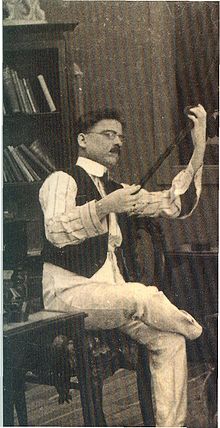- Dadasaheb Phalke
-
Dadasaheb Phalke 
Born April 30, 1870 Died February 16, 1944 (aged 73) Dhundiraj Govind Phalke, popularly known as Dadasaheb Phalke (Marathi: दादासाहेब फाळके
 pronunciation (help·info)) (30 April 1870 - 16 February 1944) was an Indian producer-director-screenwriter, known as the father of Indian cinema.[1] Starting with his debut film, Raja Harishchandra 1913, now known as India's first full-length feature, he made 95 movies and 26 short films in his career span of 19 years, till 1937, including his most noted works: Mohini Bhasmasur (1913), Satyavan Savitri (1914), Lanka Dahan (1917), Shri Krishna Janma (1918) and Kaliya Mardan (1919).[2]
pronunciation (help·info)) (30 April 1870 - 16 February 1944) was an Indian producer-director-screenwriter, known as the father of Indian cinema.[1] Starting with his debut film, Raja Harishchandra 1913, now known as India's first full-length feature, he made 95 movies and 26 short films in his career span of 19 years, till 1937, including his most noted works: Mohini Bhasmasur (1913), Satyavan Savitri (1914), Lanka Dahan (1917), Shri Krishna Janma (1918) and Kaliya Mardan (1919).[2]The Dadasaheb Phalke Award for lifetime contribution to cinema, was instituted in his honor, by Government of India in 1969, and is the most prestigious and coveted award in Indian Cinema.[3]
Contents
Biography
Early life and education
Dhundiraj Govind Phalke was born on 30 April 1870 at Trimbakeshwar, 30 km from Nasik, Maharashtra, India,[2] where his father was an accomplished Sanskrit scholar.[4]
He joined Sir J. J. School of Art, Mumbai in 1885. After passing from J.J. School in 1890, Phalke went to the Kala Bhavan in Baroda, where he studied sculpture, engineering, drawing, painting and photography.[5]
Early career
He began his career as a small town photographer in Godhra but had to leave business after the death of his first wife and child in an outbreak of the bubonic plague. He soon met the German magician Carl Hertz, one of the 40 magicians employed by the Lumiere Brothers. Soon after, he had the opportunity to work with the Archeological Survey of India as a draftsman. However, restless with his job and its constraints, he turned to the business of printing. He specialized in lithography and oleograph, and worked for painter Raja Ravi Varma. Phalke later started his own printing press, made his first trip abroad to Germany, to learn about the latest technology and machinery.
Film
Following a dispute with his partners about the running of the press, he gave up printing and turned his attention to moving pictures, after watching a silent film, The Life of Christ and envisioning Indian gods on the screen. Phalke made his first film, Raja Harishchandra, in 1912; it was first shown publicly on 3 May 1913 at Mumbai's Coronation Cinema,[6] effectively marking the beginning of the Indian film industry. Around one year before, Ramchandra Gopal (known as Dadasaheb Torne) had filmed a stage drama called Pundalik and shown it in the same theater. However, the credit for making the first Indian feature film is attributed to Dadasaheb Phalke.[7]
Once again, Phalke proved successful in his new art and proceeded to make several silent films, shorts, documentary feature, educational, comic, tapping all the potential of this new medium. Film, having proved its financial viability, soon attracted businessmen who favored money over aesthetics.
Hindustan Films
Phalke formed a film company, Hindustan Films in partnership with five businessmen from Mumbai, in the hope that by having the financial aspect of his profession handled by experts in the field, he would be free to pursue the creative aspect. He set up a model studio and trained technicians, actors but, very soon, he ran into insurmountable problems with his partners. In 1920, Phalke resigned from Hindustan Films, made his first announcement of retirement from cinema, and he wrote Rangbhoomi, an acclaimed play. Lacking his extremely imaginative genius, Hindustan Films ran into deep financial loss, and he was finally persuaded to return. However, Phalke felt constrained by the business and, after directing a few films for the company, he withdrew.
Sound film
The times changed and Phalke fell victim to the emerging technology of sound film. Unable to cope with the talkies, the man who had fathered the Indian film industry became obsolete. His last silent movie Setubandhan was released in 1932 and later released with dubbing. During 1936-38, he produced his last film Gangavataran (1937), before retiring to Nashik, where he died on 16 February 1944.
Selected filmography
- Raja Harishchandra (1913)
- Shri Krishna Janma (1918)
- Kaliya Mardan (1919)
- Setu Bandhan (1932)
- Gangavataran (1937)
In popular culture
In 2009, Marathi film Harishchandrachi Factory, depicting the struggle of Dadasaheb Phalke in making Raja Harishchandra in 1913, India's first feature film, directed by theater-veteran Paresh Mokashi was selected as India's official entry to Academy Award in the Best Foreign Language Film category.[8][9][10]
Further reading
- Dadasaheb Phalke, the Father of Indian Cinema, by Bapu Vatave, National Book Trust, 2004. ISBN 81-237-4319-X.
References
- ^ Snapshot: Raja Harishchandra The Guardian.
- ^ a b Dadasaheb Phalke: The Visionary of Indian Cinema, Biography Nashik International Film Festival.
- ^ The Beginning: The Silent Movie Era Asia Studies, University of Berkeley.
- ^ Dadasaheb Phalke - Biography The Tribune, 30 April 2000.
- ^ Dada Saheb Phalke - A Distinguished Student of Kalabhavan
- ^ Overview New York Times.
- ^ http://www.nashik.com/halloffame/tribute/phalke.html
- ^ 'Harishchandrachi Factory' India's entry for Oscars Indian Express, PTI 20 September 2009.
- ^ Harishchandrachi Factory to tell story behind making of India’s first feature film Indian Express, Express News Service, 3 May 2008.
- ^ 'Harishchandrachi factory' India's entry for Oscars Press Trust of India, 20 September 2009.
External links
Categories:- Indian film directors
- Hindi-language film directors
- Marathi film directors
- Marathi cinema
- Indian film producers
- 1870 births
- 1944 deaths
- Sir J. J. School of Art alumni
- People from Vadodara
- People from Nashik
Wikimedia Foundation. 2010.

